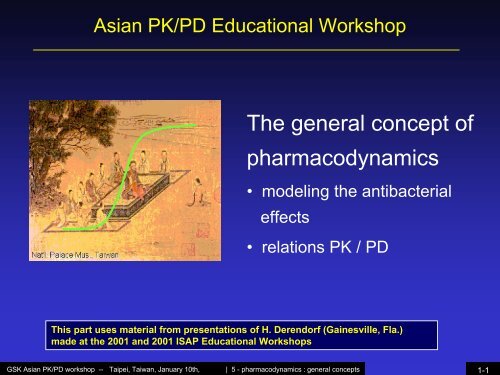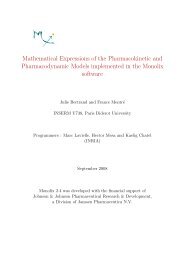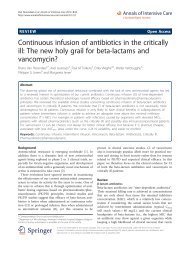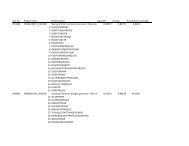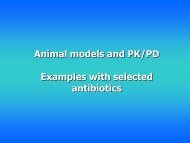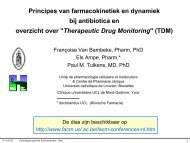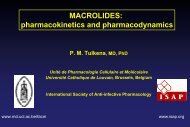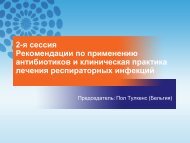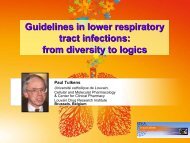GSK-Taiwan PK-PD workshop: Pharmacodynamics
GSK-Taiwan PK-PD workshop: Pharmacodynamics
GSK-Taiwan PK-PD workshop: Pharmacodynamics
Create successful ePaper yourself
Turn your PDF publications into a flip-book with our unique Google optimized e-Paper software.
Asian <strong>PK</strong>/<strong>PD</strong> Educational Workshop<br />
The general concept of<br />
pharmacodynamics<br />
• modeling the antibacterial<br />
effects<br />
• relations <strong>PK</strong> / <strong>PD</strong><br />
This part uses material from presentations of H. Derendorf (Gainesville, Fla.)<br />
made at the 2001 and 2001 ISAP Educational Workshops<br />
<strong>GSK</strong> Asian <strong>PK</strong>/<strong>PD</strong> <strong>workshop</strong> -- Taipei, <strong>Taiwan</strong>, January 10th, | 5 - pharmacodynamics : general concepts<br />
1-1
What is pharmacodynamics <br />
What the drug does to the body ...<br />
<strong>GSK</strong> Asian <strong>PK</strong>/<strong>PD</strong> <strong>workshop</strong> -- Taipei, <strong>Taiwan</strong>, January 10th, | 5 - pharmacodynamics : general concepts<br />
1-2
Pharmacokinetics<br />
<strong>Pharmacodynamics</strong><br />
Concentration at<br />
the site of<br />
infection<br />
Therapeutic<br />
effects<br />
Dosage<br />
Serum concentration<br />
varying<br />
over time<br />
Concentration in<br />
non-target<br />
tissues<br />
Toxic<br />
effects<br />
<strong>GSK</strong> Asian <strong>PK</strong>/<strong>PD</strong> <strong>workshop</strong> -- Taipei, <strong>Taiwan</strong>, January 10th, | 5 - pharmacodynamics : general concepts<br />
1-3
Pharmacokinetics - <strong>Pharmacodynamics</strong><br />
0.4<br />
Pharmacokinetics<br />
conc. vs time<br />
<strong>Pharmacodynamics</strong><br />
conc. vs effect<br />
Conc.<br />
Effect<br />
0.0<br />
0 25<br />
Time<br />
Conc. (log)<br />
10-3<br />
Effect<br />
1<br />
<strong>PK</strong>/<strong>PD</strong><br />
effect vs time<br />
0<br />
0<br />
Time<br />
<strong>GSK</strong> Asian <strong>PK</strong>/<strong>PD</strong> <strong>workshop</strong> -- Taipei, <strong>Taiwan</strong>, January 10th, | 5 - pharmacodynamics : general concepts<br />
1-4
Pharmacoynamics : what is the end-point <br />
Effect<br />
<strong>Pharmacodynamics</strong><br />
conc. vs effect<br />
Conc. (log)<br />
10-3<br />
1. therapeutical result<br />
• clinical ...<br />
• laboratory ...<br />
2. Biomarker<br />
Drug- or disease-induced<br />
measurable physiological,<br />
pathophysiological or<br />
biochemical change<br />
3. Surrogate end-point<br />
Biomarker that has predictive<br />
value for therapeutic outcome<br />
<strong>GSK</strong> Asian <strong>PK</strong>/<strong>PD</strong> <strong>workshop</strong> -- Taipei, <strong>Taiwan</strong>, January 10th, | 5 - pharmacodynamics : general concepts<br />
1-5
<strong>Pharmacodynamics</strong> : which are the models <br />
The yes / no model<br />
effect<br />
concentration<br />
• sharp threshold<br />
• maximal effect immediately<br />
observed<br />
This is the model assumed by<br />
• the sensitivity breakpoints<br />
approach !!<br />
• the cured / non-cured clinical<br />
endpoint !!<br />
<strong>GSK</strong> Asian <strong>PK</strong>/<strong>PD</strong> <strong>workshop</strong> -- Taipei, <strong>Taiwan</strong>, January 10th, | 5 - pharmacodynamics : general concepts<br />
1-6
<strong>Pharmacodynamics</strong> : which are the models <br />
The linear model<br />
effect<br />
concentration<br />
• continuouly increasing<br />
effect<br />
• effect matches dosing<br />
This is the model assumed by<br />
the "higher dosing in severe<br />
infections" approach<br />
<strong>GSK</strong> Asian <strong>PK</strong>/<strong>PD</strong> <strong>workshop</strong> -- Taipei, <strong>Taiwan</strong>, January 10th, | 5 - pharmacodynamics : general concepts<br />
1-7
<strong>Pharmacodynamics</strong> : which are the models <br />
effect<br />
The yes / no and the linear<br />
models are almost never<br />
observed in true phamacological<br />
responses !!<br />
concentration<br />
Drugs (includig antibiotics) act<br />
indeed by binding to their<br />
targets,<br />
effect<br />
and this binding is saturable ...<br />
concentration<br />
<strong>GSK</strong> Asian <strong>PK</strong>/<strong>PD</strong> <strong>workshop</strong> -- Taipei, <strong>Taiwan</strong>, January 10th, | 5 - pharmacodynamics : general concepts<br />
1-8
The E-max model ...<br />
• Drug concentration<br />
increases at low initial<br />
values seem more effective<br />
than at large initial values<br />
• There is a maximal effect<br />
corresponding to maximal<br />
receptor / target site<br />
occupancy<br />
EC 50<br />
This is the classical model<br />
used for non-antiinfective<br />
drugs...<br />
<strong>GSK</strong> Asian <strong>PK</strong>/<strong>PD</strong> <strong>workshop</strong> -- Taipei, <strong>Taiwan</strong>, January 10th, | 5 - pharmacodynamics : general concepts<br />
1-9
The conventional E-max model is inadequate…<br />
It ignores<br />
• the threshold in effect seen<br />
when passing across the MIC<br />
• the fact that antibiotics may be<br />
• bacteriostatic, or<br />
• bactericidal<br />
• the influence of time ...<br />
EC 50<br />
But, this model is useful to obtain a first description<br />
of dose-response effects … if appropriate corrections<br />
are introduced<br />
<strong>GSK</strong> Asian <strong>PK</strong>/<strong>PD</strong> <strong>workshop</strong> -- Taipei, <strong>Taiwan</strong>, January 10th, | 5 - pharmacodynamics : general concepts<br />
1-10
Mathematical representations of the E-max model<br />
ln EC 50 - 2<br />
EC 50<br />
Arithmetic abcissa<br />
Logarithmic abcissa<br />
<strong>GSK</strong> Asian <strong>PK</strong>/<strong>PD</strong> <strong>workshop</strong> -- Taipei, <strong>Taiwan</strong>, January 10th, | 5 - pharmacodynamics : general concepts<br />
1-11
Why a logarithmic abcissa ...<br />
E max<br />
MaximaI<br />
intensity of<br />
the response<br />
E 50%<br />
ln EC 50 - 2<br />
E<br />
<br />
E<br />
EC<br />
max<br />
n<br />
50<br />
C<br />
C<br />
n<br />
n<br />
Logarithmic abcissa<br />
<strong>GSK</strong> Asian <strong>PK</strong>/<strong>PD</strong> <strong>workshop</strong> -- Taipei, <strong>Taiwan</strong>, January 10th, | 5 - pharmacodynamics : general concepts<br />
1-12
The E-max model may be used to incorporate<br />
the yes/no and the linear models within limits...<br />
steep<br />
The "shape factor"<br />
describes the steepness<br />
of the response ...<br />
pseudolinear<br />
E<br />
<br />
E<br />
EC<br />
max<br />
n<br />
50<br />
C<br />
C<br />
n<br />
n<br />
<strong>GSK</strong> Asian <strong>PK</strong>/<strong>PD</strong> <strong>workshop</strong> -- Taipei, <strong>Taiwan</strong>, January 10th, | 5 - pharmacodynamics : general concepts<br />
1-13
First points to consider in pharmacodynamic<br />
modeling of antibiotic response<br />
• Emax<br />
• steepness<br />
• point of initial<br />
response<br />
This is a description at a FIXED time only ...<br />
<strong>GSK</strong> Asian <strong>PK</strong>/<strong>PD</strong> <strong>workshop</strong> -- Taipei, <strong>Taiwan</strong>, January 10th, | 5 - pharmacodynamics : general concepts<br />
1-14
What means E-max (at a given time point) <br />
absolute antibactrerial effect<br />
(killing in arbitrary units)<br />
Highly bactericidal<br />
• fluoroquinolones<br />
• aminoglycosides<br />
Poorly bactericidal<br />
• vancomycin<br />
• macrolides<br />
• tetracyclines<br />
<strong>GSK</strong> Asian <strong>PK</strong>/<strong>PD</strong> <strong>workshop</strong> -- Taipei, <strong>Taiwan</strong>, January 10th, | 5 - pharmacodynamics : general concepts<br />
1-15
What does steepnes mean<br />
relative antibacterial effect<br />
(% of maximal)<br />
Highly concentrationdependent<br />
AB (as from MIC)<br />
• fluoroquinolones<br />
• aminoglycosides<br />
• oritavancin<br />
Poorly concentrationdependent<br />
AB<br />
once above threshold (=MIC)<br />
• -lactams<br />
• vancomycin<br />
<strong>GSK</strong> Asian <strong>PK</strong>/<strong>PD</strong> <strong>workshop</strong> -- Taipei, <strong>Taiwan</strong>, January 10th, | 5 - pharmacodynamics : general concepts<br />
1-16
<strong>Pharmacodynamics</strong> : influence of time ...<br />
All antibiotics are dependent on time...<br />
<strong>GSK</strong> Asian <strong>PK</strong>/<strong>PD</strong> <strong>workshop</strong> -- Taipei, <strong>Taiwan</strong>, January 10th, | 5 - pharmacodynamics : general concepts<br />
1-17
<strong>Pharmacodynamics</strong> : influence of time ...<br />
But time is relatively unimportant for<br />
highly concentration-dependent drugs<br />
A 3 log reduction will be achieved in 4h, 2h or less<br />
depending on concentration...<br />
<strong>GSK</strong> Asian <strong>PK</strong>/<strong>PD</strong> <strong>workshop</strong> -- Taipei, <strong>Taiwan</strong>, January 10th, | 5 - pharmacodynamics : general concepts<br />
1-18
<strong>Pharmacodynamics</strong> : influence of time ...<br />
Whereas time becomes the CRITICAL<br />
parameter for antibiotics with low<br />
concentration dependency<br />
1 log<br />
2 logs<br />
3 logs<br />
You always need more than 8h to achive a 3 logs kill<br />
<strong>GSK</strong> Asian <strong>PK</strong>/<strong>PD</strong> <strong>workshop</strong> -- Taipei, <strong>Taiwan</strong>, January 10th, | 5 - pharmacodynamics : general concepts<br />
1-19
Time-dependent antibiotics with shott half-lifes<br />
are ineffective if not administered frequently<br />
CFU/mL<br />
10 14<br />
10 13<br />
10 12<br />
10 11<br />
10 10<br />
10 9<br />
10 8<br />
10 7<br />
10 6<br />
10 5<br />
10 4<br />
10 3<br />
10 2<br />
10 1<br />
10 0<br />
0 2 4 6 8 10<br />
Time (h)<br />
control<br />
2g<br />
4g<br />
8g<br />
Piperacillin<br />
modeling as<br />
one single<br />
injection<br />
Limits of time during which<br />
the AB concentr. remains<br />
effective for the dose<br />
considered (2 g, 4 g, 8 g)<br />
...<br />
<strong>GSK</strong> Asian <strong>PK</strong>/<strong>PD</strong> <strong>workshop</strong> -- Taipei, <strong>Taiwan</strong>, January 10th, | 5 - pharmacodynamics : general concepts<br />
1-20
Low doses of poorly-concentration dependent<br />
antibiotics require frequent administration<br />
Piperacillin modeled for a Cmax of 50 mg/L<br />
CFU/mL<br />
10 11<br />
10 10<br />
50µg/mL q24h<br />
10 9<br />
10 8<br />
10 7<br />
10 6<br />
10 5<br />
10 4<br />
10 3<br />
10 2<br />
0 5 10 15 20 25<br />
Time (h)<br />
CFU/mL<br />
10 11<br />
10 10<br />
50µg/mL q8h<br />
10 9<br />
10 8<br />
10 7<br />
10 6<br />
10 5<br />
10 4<br />
10 3<br />
10 2<br />
0 5 10 15 20 25<br />
Time (h)<br />
CFU/mL<br />
10 11<br />
10 10<br />
50µg/mL q4h<br />
10 9<br />
10 8<br />
10 7<br />
10 6<br />
10 5<br />
10 4<br />
10 3<br />
10 2<br />
0 5 10 15 20 25<br />
Time (h)<br />
once-a-day q 8h q 4h<br />
<strong>GSK</strong> Asian <strong>PK</strong>/<strong>PD</strong> <strong>workshop</strong> -- Taipei, <strong>Taiwan</strong>, January 10th, | 5 - pharmacodynamics : general concepts<br />
1-21
This where we are now ...<br />
<strong>PK</strong><br />
<strong>PD</strong><br />
Therapeutic<br />
effects<br />
Dosing<br />
• C max<br />
• AUC<br />
• half-life<br />
• E max<br />
• concentration<br />
• time<br />
Toxic<br />
effects<br />
<strong>GSK</strong> Asian <strong>PK</strong>/<strong>PD</strong> <strong>workshop</strong> -- Taipei, <strong>Taiwan</strong>, January 10th, | 5 - pharmacodynamics : general concepts<br />
1-22


